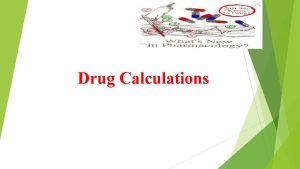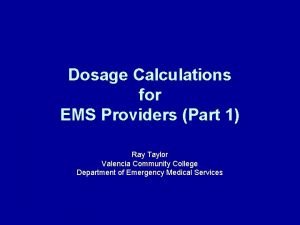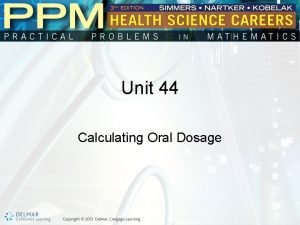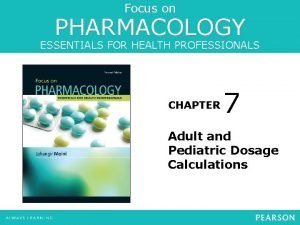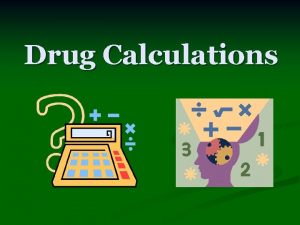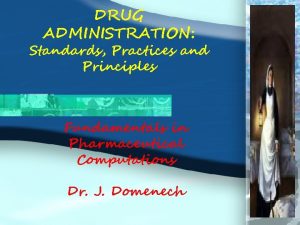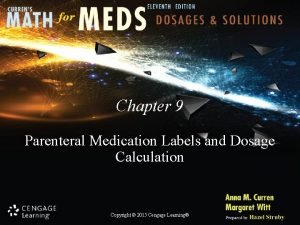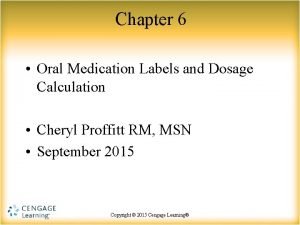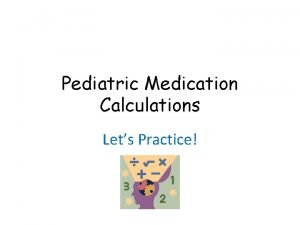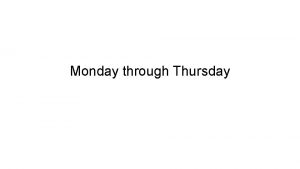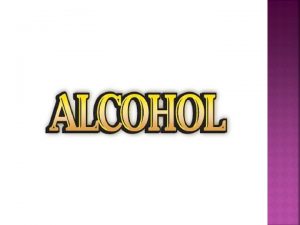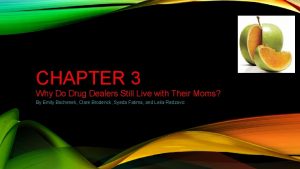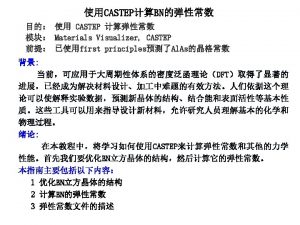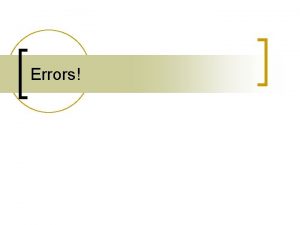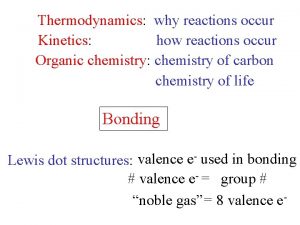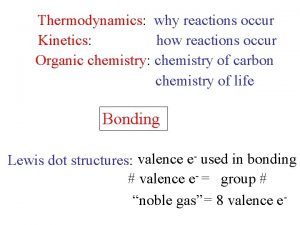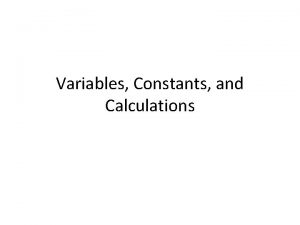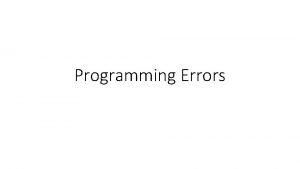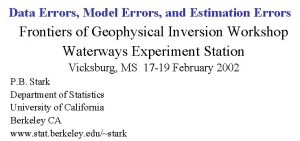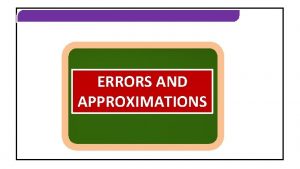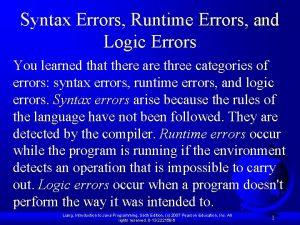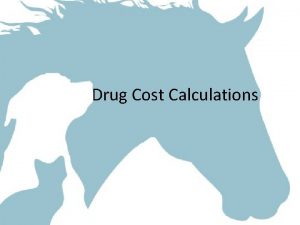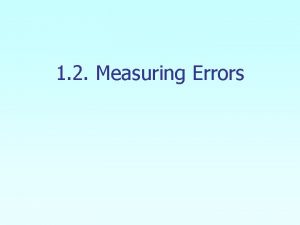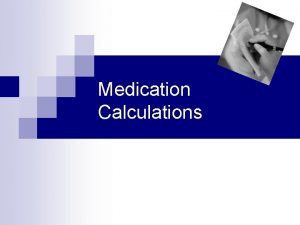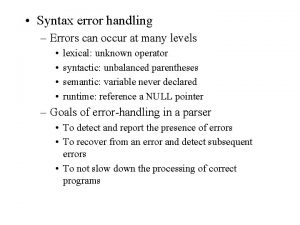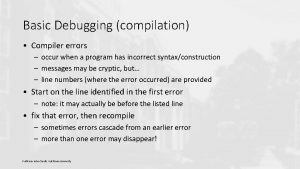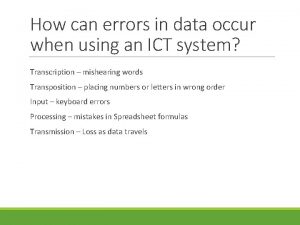Drug Calculations Why do drug calculation errors occur






















- Slides: 22

Drug Calculations

Why do drug calculation errors occur? Illegible or inaccurate prescription charts. n Workload. n Staffing levels. n Length of shift. n Number of bank/agency staff. n Lack of knowledge of medications. n Too many distractions/interruptions. n Poor mathematical ability. n

Practical Tips Do the calculation on your own and then with someone else – cross-check answers. n Do not defer because of status, authority or experience. n Use calculators or other aids. n Take time, avoid interruptions and recheck. n Do not shoe off mental arithmetic skills. n If unsure, do not give. Seek assistance. n Answers that look wrong are usually wrong. n

Conversions Formula 1: Converting a larger unit of weight, measure or volume to a smaller one Kilogram (kg) to gram (g) Gram (g) to milligram (mg) Milligram (mg) to microgram (µg) Microgram (µg) to nanogram (ng) e. g. 1 gram = 1000 milligrams 1 milligram = 1000 micrograms 0. 5 milligram = 500 micrograms 0. 01 milligram = ? ? x x 1000

Conversions Formula 2: Converting a smaller unit of weight, measure or volume to a larger one Microgram (µg) to milligram (mg) ÷ 1000 Milligram (mg) to gram (g) ÷ 1000 Gram (g) to kilogram (kg) ÷ 1000 Convert 8500 micrograms to milligrams = 8. 5 mg e. g. A patient is prescribed 1. 2 g benzylpenicillin.

Conversions Convert 1. 2 g (grams) into mg (milligrams) 1200 mg n Convert 0. 25 g (grams) into mg (milligrams) 250 mg n Convert 650 mg into grams 0. 65 g n Convert 2250 micrograms into n

100 mcg of Digoxin liquid is equivalent to 125 micrograms of Digoxin tablets. n How many mls of digoxin liquid 0. 05 mg/ml is equivalent to 375 micrograms of Digoxin tablets? Step 1: Convert 0. 05 mg to micrograms = 50 micrograms Step 2: 50 micrograms/ml. = 100 micrograms = 2 ml Step 3: 100 micrograms/2 ml = 125 micrograms of tablets 125 X 3 = 375 Answer: 6 ml of digoxin liquid is equivalent to

Percentages This is the number of grams in 100 g or 100 ml of product. n n n 1% solution of drug X = 1 g of X in 100 ml. 5% powder of drug X = 5 g in 100 g. 10% solution of drug X = 10 g of X in 100 ml. 0. 9% Saline solution = 0. 9 g in 100 ml. 5% dextrose is 5 g per 100 ml 70% of isopropyl alcohol is 70 ml per

Percentages How many mg per 100 ml is 5% dextrose? Step 1: Convert 5% to grams per ml 5% dextrose = 5 g per 100 ml n Step 2 Covert 5 grams to milligrams 5 x 1000 = 5000 mg per 100 ml Therefore there are 5000 mg per

Magnesium sulphate 50% comes in 2 ml ampoules. How many ml would be needed to give an 3 gram dose? 50% = 50 g in 100 ml. 0. 5 g per ml 1 g in 2 ml 3 grams = 6 mls. 2+

Ratios Adrenaline 1 : 10 000 = 1 g per 10 000 ml ( 1 mg per 10 ml) Adrenaline 1 : 1000 = 1 g per 1000 ml ( 1 mg per ml)

Ratios n n During resuscitation a 10 ml pre-filled syringe of adrenaline (1 : 10 000) is administered to the patient. How many milligrams (mg) of adrenaline is this per 10 ml? Step 1 : Convert 1 : 10 000 to grams per 10 000 ml 1 g per 10 000 ml Step 2 : Convert 1 g to mg 1 g = 1000 mg Step 3 : Calculate the unit of weight per 10 ml 1000 x 10 ÷ 10 000= 1 mg per 10 ml

Calculating dosages based on body weight n A child weighing 18 kg is prescribed cefotaxime 200 mcg/kg. How much of the drug should be given? 3600 micrograms or 3. 6 mg

Medication prescribed in doses either greater or smaller than the preparations available Volume or dose required = dose required x volume of vial Total amount of drug in vial What you want x What you have ÷ What you have got

A patient is prescribed 700 mg of Phenytoin syrup. The preparation is 30 mg in 5 mls. How much would you give? What you want x What you have ÷ What you have got Volume or dose required = dose required x volume of vial Total amount of drug in vial 700 x 5 = 3500 ÷ 30 = (30 ÷ 5 = 6. 116. 6 mls 6 mgs per ml, therefore 116. 6 mls x 6 =

Gentamicin injection is 40 mg/ml. The patient is prescribed Gentamicin IV 500 mgs. What volume should be given? 500 x 1 = 500 ÷ 40 = 12. 5 mls How would this dose be administered?

The prescribed medication is aciclovir 650 mg IV. It is available in 500 mg vials which your ward normally dilutes with 20 ml of water for injections. How many ml will you give to your patient? 650 x 20 = 13000 ÷ 500 = The amount to be given is 26 ml.

Proportional reasoning method to calculate dosage Doubling and halving 75 mg 2 ml 150 m g 4 ml 37. 5 1 ml

A patient is prescribed 300 mg of a drug. The drug is available in 75 mg in 2 ml. How would you work out the required dose and equivalent volume? 75 mg 150 m g 300 m g 2 ml 4 ml 8 ml

A patient has been prescribed Furosemide 80 mg IV. The ampoule available is 100 mg/2 ml. What volume should be administered? Reducing to the simplest unit • 100 mg………… 2 ml • 10 mg…………. 0. 2 ml (dividing by 10) • 80 mg…………. 1. 6 ml (multiplying by 8) Building blocks • • • 100 mg …………. . 2 ml 50 mg…………… 1 ml (halving) 25 mg……………. 0. 5 ml (halving) 5 mg…………… 0. 1 ml (dividing by 5) 80 mg = 50 mg + 25 mg + 5 mg = 1. 6 ml Visual aids • • 2 ml 1. 5 ml 1 ml 0. 5 ml 100 mg 75 mg 50 mg 25 mg

Continuous or intermittent infusions delivered via a medical device A patient is prescribed 900 mg of a drug to be given via an intravenous infusion over 24 hours. The drug is further diluted in 500 mls of 5% Dextrose. How many mls per hour would give? 20. 8 ml per hour

Proactive Strategies n n n Increased focus on the topic during undergraduate training. Drug calculation tests. VLE – Maths for Medicine. Increased access to advice and assistance Pocket size cards with formulae.
 Types of connections in steel structures
Types of connections in steel structures Why why why why
Why why why why Medication calculation formula
Medication calculation formula Dose on hand divided by desired
Dose on hand divided by desired Drug calculation formula
Drug calculation formula Clarks formula
Clarks formula Drug calculation formula
Drug calculation formula Drug dose calculation formula
Drug dose calculation formula Parenteral medication examples
Parenteral medication examples Oral dosage calculations tablets and capsules
Oral dosage calculations tablets and capsules Drug dose calculation
Drug dose calculation Drug calculation
Drug calculation Changes after death
Changes after death Why does hybridization occur
Why does hybridization occur Hybridization and the localized electron model
Hybridization and the localized electron model Why did the yazoo land fraud occur?
Why did the yazoo land fraud occur? Why do earthquakes occur
Why do earthquakes occur Big whack theory
Big whack theory Why does refraction occur brainpop
Why does refraction occur brainpop Don't ask why why why
Don't ask why why why Types of adulteration of crude drugs
Types of adulteration of crude drugs Why is alcohol considered a drug? *
Why is alcohol considered a drug? * Why do drug dealers still live with their moms?
Why do drug dealers still live with their moms?


